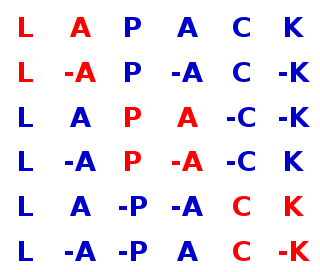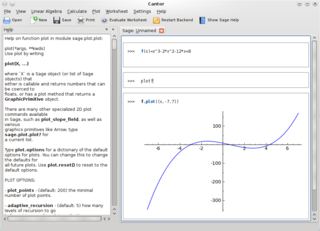
In computing, floating-point arithmetic (FP) is arithmetic using formulaic representation of real numbers as an approximation to support a trade-off between range and precision. For this reason, floating-point computation is often used in systems with very small and very large real numbers that require fast processing times. In general, a floating-point number is represented approximately with a fixed number of significant digits and scaled using an exponent in some fixed base; the base for the scaling is normally two, ten, or sixteen. A number that can be represented exactly is of the following form:

GW-BASIC is a dialect of the BASIC programming language developed by Microsoft from IBM BASICA. Functionally identical to BASICA, its BASIC interpreter is a fully self-contained executable and does not need the Cassette BASIC ROM found in the original IBM PC. It was bundled with MS-DOS operating systems on IBM PC compatibles by Microsoft.
IEEE 754-1985 was an industry standard for representing floating-point numbers in computers, officially adopted in 1985 and superseded in 2008 by IEEE 754-2008, and then again in 2019 by minor revision IEEE 754-2019. During its 23 years, it was the most widely used format for floating-point computation. It was implemented in software, in the form of floating-point libraries, and in hardware, in the instructions of many CPUs and FPUs. The first integrated circuit to implement the draft of what was to become IEEE 754-1985 was the Intel 8087.
MIPS is a reduced instruction set computer (RISC) instruction set architecture (ISA) developed by MIPS Computer Systems, now MIPS Technologies, based in the United States.

Microsoft Excel is a spreadsheet developed by Microsoft for Windows, macOS, Android and iOS. It features calculation or computation capabilities, graphing tools, pivot tables, and a macro programming language called Visual Basic for Applications (VBA). Excel forms part of the Microsoft Office suite of software.
Microsoft BASIC is the foundation software product of the Microsoft company and evolved into a line of BASIC interpreters adapted for many different microcomputers. It first appeared in 1975 as Altair BASIC, which was the first version of BASIC published by Microsoft as well as the first high-level programming language available for the Altair 8800 microcomputer.

GNU Multiple Precision Arithmetic Library (GMP) is a free library for arbitrary-precision arithmetic, operating on signed integers, rational numbers, and floating-point numbers. There are no practical limits to the precision except the ones implied by the available memory (operands may be of up to 232−1 bits on 32-bit machines and 237 bits on 64-bit machines). GMP has a rich set of functions, and the functions have a regular interface. The basic interface is for C, but wrappers exist for other languages, including Ada, C++, C#, Julia, .NET, OCaml, Perl, PHP, Python, R, Ruby, and Rust. Prior to 2008, Kaffe, a Java virtual machine, used GMP to support Java built-in arbitrary precision arithmetic. Shortly after, GMP support was added to GNU Classpath.

C99 is an informal name for ISO/IEC 9899:1999, a past version of the C programming language standard. It extends the previous version (C90) with new features for the language and the standard library, and helps implementations make better use of available computer hardware, such as IEEE 754-1985 floating-point arithmetic, and compiler technology. The C11 version of the C programming language standard, published in 2011, replaces C99.

Windows Calculator is a software calculator developed by Microsoft and included in Windows. It has four modes: standard, scientific, programmer, and a graphing mode. The standard mode includes a number pad and buttons for performing arithmetic operations. The scientific mode takes this a step further and adds exponents and trigonometric function, and programmer mode allows the user to perform operations related to computer programming. Recently, a graphing mode was added to the Calculator, allowing users to graph equations on a coordinate plane.

LAPACK is a standard software library for numerical linear algebra. It provides routines for solving systems of linear equations and linear least squares, eigenvalue problems, and singular value decomposition. It also includes routines to implement the associated matrix factorizations such as LU, QR, Cholesky and Schur decomposition. LAPACK was originally written in FORTRAN 77, but moved to Fortran 90 in version 3.2 (2008). The routines handle both real and complex matrices in both single and double precision.
x87 is a floating-point-related subset of the x86 architecture instruction set. It originated as an extension of the 8086 instruction set in the form of optional floating-point coprocessors that worked in tandem with corresponding x86 CPUs. These microchips had names ending in "87". This was also known as the NPX. Like other extensions to the basic instruction set, x87 instructions are not strictly needed to construct working programs, but provide hardware and microcode implementations of common numerical tasks, allowing these tasks to be performed much faster than corresponding machine code routines can. The x87 instruction set includes instructions for basic floating-point operations such as addition, subtraction and comparison, but also for more complex numerical operations, such as the computation of the tangent function and its inverse, for example.

Mathomatic is a free, portable, general-purpose computer algebra system (CAS) that can symbolically solve, simplify, combine, and compare algebraic equations, and can perform complex number, modular, and polynomial arithmetic, along with standard arithmetic. It does some symbolic calculus, numerical integration, and handles all elementary algebra except logarithms. Trigonometric functions can be entered and manipulated using complex exponentials, with the GNU m4 preprocessor. Not currently implemented are general functions like f(x), arbitrary-precision and interval arithmetic, and matrices.
In C and related programming languages, long double refers to a floating-point data type that is often more precise than double precision though the language standard only requires it to be at least as precise as double. As with C's other floating-point types, it may not necessarily map to an IEEE format.

CUDA is a parallel computing platform and application programming interface (API) that allows software to use certain types of graphics processing unit (GPU) for general purpose processing – an approach called general-purpose computing on GPUs (GPGPU). CUDA is a software layer that gives direct access to the GPU's virtual instruction set and parallel computational elements, for the execution of compute kernels.
IronRuby is an implementation of the Ruby programming language targeting Microsoft .NET Framework. It is implemented on top of the Dynamic Language Runtime (DLR), a library running on top of the Common Language Infrastructure that provides dynamic typing and dynamic method dispatch, among other things, for dynamic languages.
IEEE 754-2008 was published in August 2008 and is a significant revision to, and replaces, the IEEE 754-1985 floating-point standard, while in 2019 it was updated with a minor revision IEEE 754-2019. The 2008 revision extended the previous standard where it was necessary, added decimal arithmetic and formats, tightened up certain areas of the original standard which were left undefined, and merged in IEEE 854.
In computing, half precision is a binary floating-point computer number format that occupies 16 bits in computer memory. It is intended for storage of floating-point values in applications where higher precision is not essential, in particular computer graphics images and neural networks.
In computing, quadruple precision is a binary floating point–based computer number format that occupies 16 bytes with precision at least twice the 53-bit double precision.

Multiple Precision Integers and Rationals (MPIR) is an open-source software multiprecision integer library forked from the GNU Multiple Precision Arithmetic Library (GMP) project. It consists of much code from past GMP releases, and some original contributed code.











